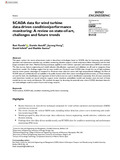JavaScript is disabled for your browser. Some features of this site may not work without it.
| dc.contributor.author | Pandit, Ravi | |
| dc.contributor.author | Astolfi, Davide | |
| dc.contributor.author | Hong, Jiarong | |
| dc.contributor.author | Infield, David | |
| dc.contributor.author | Santos, Matilde | |
| dc.date.accessioned | 2022-09-22T11:47:03Z | |
| dc.date.available | 2022-09-22T11:47:03Z | |
| dc.date.issued | 2022-09-19 | |
| dc.identifier.citation | Pandit R, Astolfi D, Hong J, et al., (2023) SCADA data for wind turbine data-driven condition/performance monitoring: A review on state-of-art, challenges and future trends, Wind Engineering, Volume 47, Issue 2, April 2023, pp. 422–441 | en_UK |
| dc.identifier.issn | 0309-524X | |
| dc.identifier.uri | https://doi.org/10.1177/0309524X221124031 | |
| dc.identifier.uri | https://dspace.lib.cranfield.ac.uk/handle/1826/18464 | |
| dc.description.abstract | This paper reviews the recent advancement made in data-driven technologies based on SCADA data for improving wind turbines’ operation and maintenance activities (e.g. condition monitoring, decision support, critical components failure detections) and the challenges associated with them. Machine learning techniques applied to wind turbines’ operation and maintenance (O&M) are reviewed. The data sources, feature engineering and model selection (classification, regression) and validation are all used to categorise these data-driven models. Our findings suggest that (a) most models use 10-minute mean SCADA data, though the use of high-resolution data has shown greater advantages as compared to 10-minute mean value but comes with high computational challenges. (b) Most of SCADA data are confidential and not available in the public domain which slows down technological advancements. (c) These datasets are used for both, the classification and regression of wind turbines but are used in classification extensively. And, (d) most commonly used data-driven models are neural networks, support vector machines, probabilistic models and decision trees and each of these models has its own merits and demerits. We conclude the paper by discussing the potential areas where SCADA data-based data-driven methodologies could be used in future wind energy research. | en_UK |
| dc.language.iso | en | en_UK |
| dc.publisher | Sage | en_UK |
| dc.rights | Attribution 4.0 International | * |
| dc.rights.uri | http://creativecommons.org/licenses/by/4.0/ | * |
| dc.subject | wind turbines | en_UK |
| dc.subject | SCADA data | en_UK |
| dc.subject | condition monitoring | en_UK |
| dc.subject | performance monitoring | en_UK |
| dc.title | SCADA data for wind turbine data-driven condition/performance monitoring: A review on state-of-art, challenges and future trends | en_UK |
| dc.type | Article | en_UK |
Files in this item
The following license files are associated with this item:
This item appears in the following Collection(s)
-
Staff publications (SATM) [4365]

